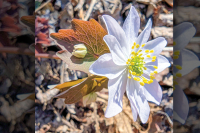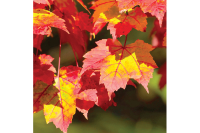Notes from a plant nerd: Oh balsam tree, oh balsam tree
 Fir trees like these have rounded needles that are soft to the touch, unlike the pointed ends of the spruce. Adam Bigelow photo
Fir trees like these have rounded needles that are soft to the touch, unlike the pointed ends of the spruce. Adam Bigelow photo
At the highest elevations of the Southern Appalachians grow two evergreen trees that give the Balsam Mountains their name — red spruce (Picea rubens) and Fraser fir (Abies fraseri).
Both of these tree species hold onto their leaves all winter long, leaving the mountaintops covered in a dark green hue. This high-elevation forest is representative of the boreal forest that rings the globe just below the Artic Circle, across Canada, northern Europe, Siberia and then southward into Southern Appalachia. It is a remnant from the last ice age.
Leaves of coniferous, or cone-bearing, trees are referred to as “needles.” Pines (Pinus spp.), cedars (Cedrus spp.), hemlocks (Tsuga spp.) and bald cypress (Taxodium spp.) are but a few examples of trees that have needles for leaves. An advantage to having needles is a highly reduced surface area that limits water loss through evapotranspiration, which is a fancy word for how plants move water up from the roots and out through the leaves. Leaves with a smaller surface area will retain a lot more water than plants with broad leaves. This helps many evergreen trees survive the harsh cold and dry conditions of winter.
The red spruce, like all spruces, has needles that are sharp and end in a point. In school, I learned to emphasize the “s” in spruce, as in “Ssspruces are sssharp.” Whereas the Fraser fir has needles that are rounded at the tip and soft to the touch. The way to remember this is that “fir is soft” like the soft fur on your animals as you pet them. I still use this mnemonic when teaching these plants, but I’ve learned another way to remember their differences that is based on the colloquial names for these species used in Southern Appalachia.
Mountainfolk refer to both of these trees as balsams or firs. And they have split them up into a male and female dichotomy that can be helpful when trying to identify them and tell them apart from each other. Known locally as “he-balsam” and “she-balsam”, or “he-fir” and “she-fir” the red spruce and Fraser fir (respectively) can be identified partly by the shape and feel of their needles. And while there are other differences that set them apart, the difference in their needles is distinctive and easy to remember.
Why use “he” and “she” to describe the tree needles? The needles of the feminized Fraser firs are rounded at the tip and are therefore soft and inviting like a mother’s touch. This is why they are the most popular holiday tree on the east coast of the U.S., as there is no pain while placing ornaments on their branches, while the pointed needles of the masculinized red spruce are a bunch of little pricks. Every ornament hung would hurt, but there is no penalty for putting a star on the soft fir trees.
Related Items
The balsam trees have been dealing with a lot of stresses way up on the mountaintops that go far beyond the extremes of temperature and weather they normally experience living above 5,000 feet in elevation. Acid rain and pollution have weakened their defenses. They have survived the attack of the balsam wooly adelgid (Adelgis piceae), a cousin to the insect killing hemlock trees, the hemlock wooly adelgid (Adelgis tsugae). The greatest threat to these forest ecosystems is the increasing impacts of human-caused climate change, especially the general trend towards warmer nighttime temperatures, which the balsams can’t survive.
As someone who is always curious about the use and history of words, I often wondered about the connection between the balsam trees and balsamic vinegar. Prior to researching this, I figured that the vinegar was made in barrels made of balsa wood. Turns out that the connection is from the root word “balm” which is a healing ointment that historically was created using the resinous sap of coniferous trees, like the balsams.
Whether or not you celebrate the season by bringing a tree into your home, or like me enjoy walking among the balsam trees in their natural habitat, I hope that the sight of these trees is a balm for your soul.
(Adam Bigelow lives in Cullowhee. He leads weekly wildflower walks most Fridays and offers consultations and private group tours through Bigelow’s Botanical Excursions. This email address is being protected from spambots. You need JavaScript enabled to view it..)













